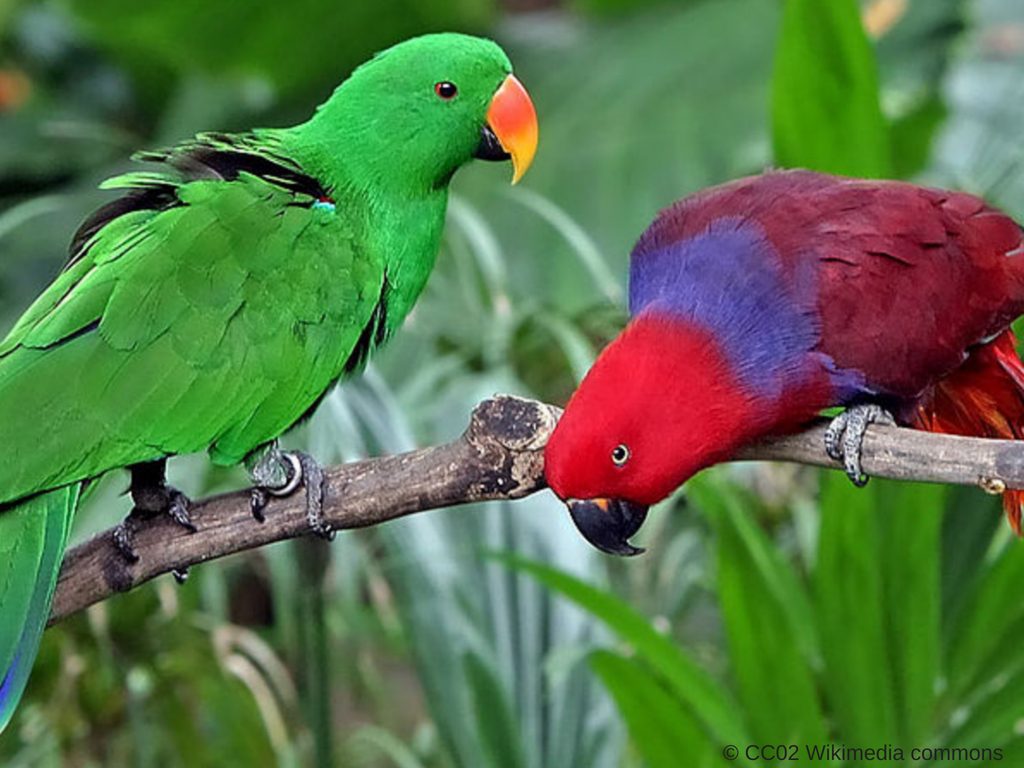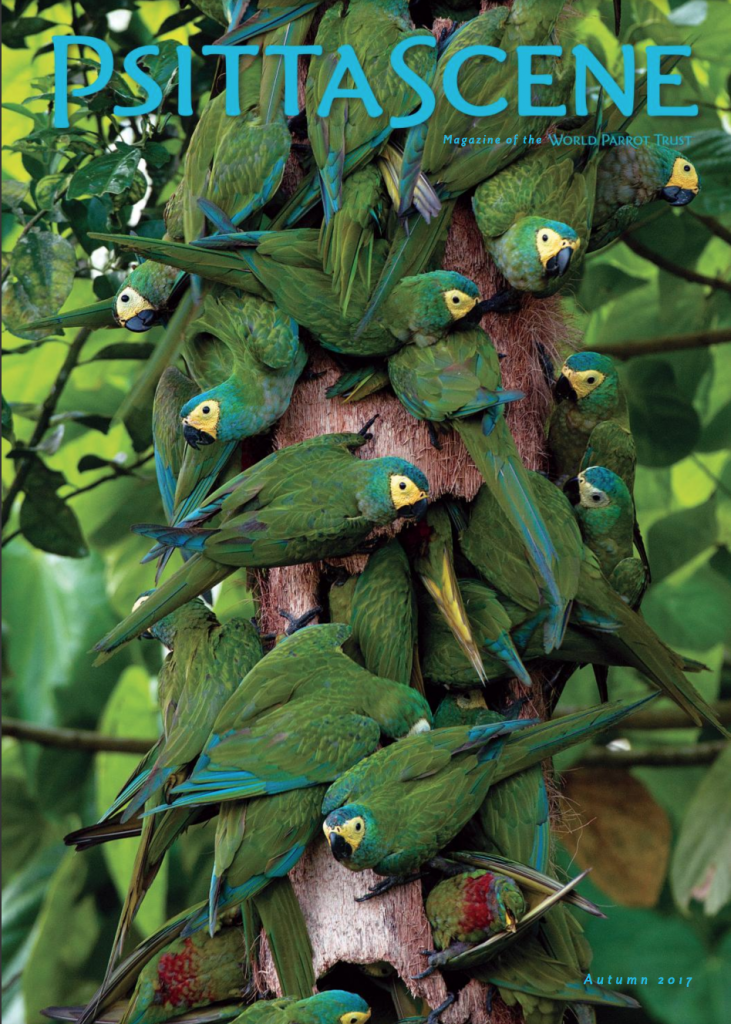
Interesting Parrot Habits & Characteristics
A Duchess Lorikeet acrobatically forages for nectar with its unique brush tongue, twisting this way and that and clinging upside down to branches. A female Vasa Parrot experiences an extraordinary plumage change when coming into breeding condition. The Kea includes general mayhem in some of its daily habits. And the list goes on…
Parrots as a group are fascinating creatures, but some of these beguiling birds are definitely edgier than others, having evolved some very interesting behaviours and/or physical characteristics.
The Lories
Unique Adaptation for Special Food

Lories and lorikeets, from the subfamily Loriinae, have glossy, colourful plumage and elongated bills – but the most interesting part of these birds is their brush‐like tongue, coated on the tip with papillae, or finger‐like projections.
Built for specialized feeding on nectar, these handy accessories harvest pollen, nectar and sometimes an insect or two, all the while spreading around valuable genetic material from flower to flower – thereby ensuring future reproduction of these vital plants.
And they do this all in the comfort of the warm, tropical regions of the world: lories and lorikeets are confined to an area that encompasses the eastern Pacific Ocean islands west to Mindanao in the S Philippines and Sunda Islands in Indonesia.
More from
World Parrot Trust
Get a free subscription to PsittaScene with your WPT membership.
The Kakapo
Love is in the Air

The owlish, quiet‐mannered Kakapo would be an oddity without its ambitious breeding habits: its lack of the power of flight, island isolation, and invisibility in the forest it lives in make it a strange one indeed. But this bird does one better: its determination to breed makes it legendary.
The Kakapo, being flightless, is of course confined to the ground – but it makes the most of it. The male Kakapo, once old enough to breed, builds an epic arena from which to declare its availability to the opposite sex. Each male has an approximately 50‐hectare domain in which it maintains up to ten conspicuous bowl‐like excavations. It is in these bowls that it proclaims its readiness to available females – by emitting loud (there aren’t many of these guys left, so they have to be VERY loud) booming calls, beginning at dusk every night, on and on, for about three months.
Once a female presents herself the male proceeds with all haste to do the deed (again, there aren’t many of them – especially females) thereby preserving his seed. A very important endeavour for a species in which the total world population numbers 149.
Eclectus Parrots
Coat of Many Colours

In biology, a species is one of the basic units of biological classification and a taxonomic rank; a group of organisms capable of interbreeding and producing fertile offspring. While in many cases this definition is adequate, more precise or differing measures are often used, such as similarity of DNA, morphology or ecological niche. (Wikipedia)
It’s no surprise that when male and female Eclectus parrots were first discovered scientists thought they were two distinct species – the two birds could not be more different: males are emerald green with an orange beacon of a bill, females are candy‐apple red with stunning purple/blue highlights along the wings and belly. Then people saw them breeding together. All the time. This, among other things, led to the conclusion that they belonged to the same species.
Most parrots display sexual dimorphism (physical differences between the sexes) such as size, weight and a few colour changes, but Eclectus parrots took it to a whole other level!
The Kea
The Gangs of New Zealand

This mottled‐green New Zealand parrot, of the genus Nestor, is a generally scarce denizen of the steep‐sided, sub‐alpine areas that most sane animals shun, but it apparently enjoys – so much so that when we do see them, we really see them.
This parrot is conspicuous in that it loves to collect in gangs of 50 or more to visit car‐parks and campgrounds to rummage around in the things we humans leave sitting out while camping: tents, cars, food. Then when they’re not doing this, they enjoy rolling around in the snow, bathing in puddles and engaging in other general mayhem. Keas are more puppy than parrot, with the intelligence of inquisitive children – and this makes them one of the most interesting parrots around.
Hanging Parrots
To Sleep, to Dream…. Upside Down

Bats, it seems, have not cornered the market on unusual sleep positions. There is a group of parrots that do the same thing.
Hanging parrots, aptly titled, do just that: they sleep or rest hanging upside down. These small parrots spend their lives in trees – and they are comfortable doing just about everything in them.
They are perfectly adapted for their lives in tropical India, Indonesia and the Philippines – feeding on nectar, crawling about acrobatically, and then having a nice inverted lie‐in when they need to rest. And since they are quiet and mainly green in colour they are devilishly tricky to spot: a great adaptation for survival.
The Vasa Parrot
Mating Makeover

The Vasa Parrot is a marvelous, jet‐black parrot from Madagascar – a wonderful character that has a wide range of calls in its repertoire. Whistling, puppy‐like yapping, harsh squawks, raucous yells, and vibrating, grating sounds are some of the noises that come from this parrot and are enjoyed by other woodland creatures. But that’s not the strangest thing.
More bizarre is the female Vasa in breeding condition: in a move that would seem counterintuitive to attracting a male, the females lose all the feathers on their head, which then turns canary yellow. The bird goes from parrot‐like to vulturine in one rapid step – all to aid the reproduction of its kind.
Odds n' Ends
Weird Looking but Lovable Parrots

Last, but not least, we come to some real eccentrics: Pesquet’s parrots, found in mainland New Guinea, and Orange‐headed and Vulturine parrots, hailing from parts of South America. They are all charmingly weird and wonderful with their bare, raptor‐like heads and psittacine bodies – adaptations which, it is thought, better aid in the hygiene of the feathers while feeding on the pulpy fruit they enjoy. No muss, no fuss. Isn’t evolution grand!
In sum, the world of parrots is an absorbing one – they are birds of high intelligence, awesome beauty and prodigious charm. And the parrots in this article are even more so – in all their mysterious and splendid ways. They will be celebrated, marvelled over and hopefully protected – until the end of time.
Want to learn more? Explore 400+ different species of parrots in the WPT Parrot Encyclopedia.
© Copyright 2018 World Parrot Trust. All Rights Reserved.

